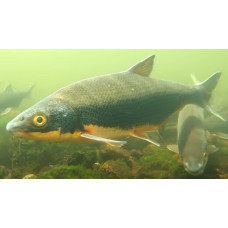Latin name
Vimba vimba
Other names
Vimba bream, vimba, zanthe, zarte
Identification
The body is moderately large, slightly compressed at the sides. Vimba vimba has a shorter anal fin and on the back, between the dorsal and caudal fins, there is a well defined keel covered with scales. The snout is lower, semi-moon shaped, and can be extended forward and downward when feeding on benthos. Back bluish grey, belly silvery white, pectoral, pelvic and anal fins pale yellowish. Before spawning, the back darkens and the middle of the belly and lower fins become red, males have white tubercles on the head.
Distribution
Widespread in the Ponto-Caspian basin and the rivers of the Baltic Sea. The Black Sea Vimba vimba is caught in the Don basin, the Kuban basin and the Sea of Azov.
Habitat
The common Vimba vimba forms marine, semi-marine and freshwater forms. It lives in the bottom layer of water. In the Caspian Sea it lives in its southern part, in the Azov Sea it lives in brackish estuaries and before the mouths of rivers.
Size
Reaches a length of 60 cm and a mass of 3 kg, with a maximum age of 17 years. Common sizes in catches are 24-26 cm and 250-350 g.
Life history and Behavior
To spawn, fish travel up rivers against the current, making "casts" over long distances. This is due to a particular attitude to spawning grounds - fish need clean water with gravel or sandy bottoms. Sometimes these conditions only exist in the upper reaches of rivers. On the eve of spawning they change their appearance: the scales darken and become shinier, the pelvic fins take on a bright orange colour. Males have white tubercles on the head and gill covers.
Food and feeding habits
The main food is moths, algae, it can also feed on mollusks, larvae, crayfish, bocoplaves. Large fish willingly eat fish. In the fall period, food for them becomes small bottom sprat. Feeding on larvae and fry is typical for Vimba vimba of the Azov Sea. Young fish in natural conditions feed on small invertebrates, and adults use a variety of bottom invertebrates - mollusks, worms, crustaceans.
Reproduction
Vimba vimba from the Don and Kuban become sexually mature in the 4th-5th year of life. Spawning is batch spawning on stony bottoms in May-June. Fecundity ranges from 34 to 128 thousand eggs, the diameter of mature eggs is 1.3 mm. The size of the larvae at hatching is about 6 mm, at the age of 12 days, with a length of 8.5 mm, they begin to feed actively. The semipalmated Caspian Vimba vimba matures at 3 years and spawns in May-June in the lower reaches of rivers and lakes. It lays its eggs on reed rhizomes. The fecundity of the fish is 22-28 thousand eggs.
Interesting facts
Studies have shown that Vimba bream are attracted to underwater lighting sources. Fishermen take advantage of this characteristic.
| Classification | |
| Phylum | Chordata |
| Class | Actinopterygii |
| Squad | Cypriniformes |
| Family | Cyprinidae |
| Genus | Vimba |
| Species | V. vimba |
| Features | |
| Conservation status | Least Concern |
| Habitat | Pelagic |
| Life span, years | 17 |
| Maximum body weight, kg | 3 |
| Maximum length, cm | 60 |
| Sailing speed, m/s | No information |
| Threat to people | Edible |
| Way of eating | Predator |
Vimba vimba
Tags: vimba vimba


